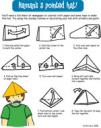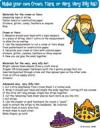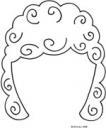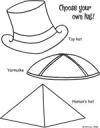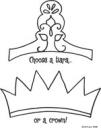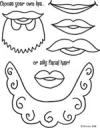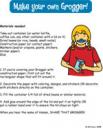That’s How We Roll
(the scroll)
(of Esther)
(by Shira Kline)
(based on the JPS translation)
Chapter 1
Once upon a time, in a land far, far away, there was a Persian king who ruled from India all the way to Ethiopia. His royal pad was in the fortress of Shushan. There was one thing for which this king was famous, and it was his partying. This guy could go for months with nothing but a disco ball and vat of good royal wine. His name was Achashverosh. Most of the people with whom he partied were so drunk they couldn’t even pronounce his name.
King Achashverosh had been partying straight for 180 days. He had all the big names there, and he had all the big games. The Persian version of Wii, Xbox, iMax, iMacs…You name it, he had it all. There was one official rule everyone had to follow at this party: There are NO RULES! Do anything you want and as much of it as you want. It’s good to be the king, huh.
Excited to show off every last bit of his wealth, Achashverosh decided to enjoy a final Seven-Day Party Blowout for everyone in Shushan. The royal decorators went to town draping everything with gold. The royal winemakers prepared enough drink that no one would go thirsty for a second. On the last day, when the king and his friends barely could touch their fingers to their noses, Achashverosh felt it would be a good time to bring in his hot-stuff queen, Vashti. He ordered Mehuman, Bizzetha, Harbona, Bigthan, Abagtha, Zethar and Carcas (the seven royal eunuchs) to bring in the gorgeous Queen Vashti wearing nothing but the royal diadem. (Know what a diadem is? Google Image it!) But Vashti was having her own party, and she wasn’t thrilled at the idea of appearing before a house full of the king’s rowdy friends. So, possibly for the first time in history, this queen said, “NO.” The king was like, “WHAT? You can’t say no to me!” So he fired her on the spot. She was booted from the kingdom that very day. And then, worried that the queen’s behavior would be a bad influence on wives everywhere, he sent out a royal edict and created a new law to ensure that all wives, high and low alike, would treat their husbands with respect.
Chapter 2
Soon after, the king’s advisors suggested that it was time to get a new queen. “Bring in young virgins from near and far. Let’s have a beauty contest right here in Shushan,” they said. “Give them tons of makeup and plenty of time to prepare themselves. Then you can choose whichever one you like the best.”
Sounded good to the king! And he sent out the order immediately.
In the town of Shushan there lived a Jew by the name of Mordechai. He had adopted his uncle’s daughter (I guess that makes her his second cousin) after her mother and father died. Esther grew up to be quite an enchanting beauty, and she too was brought to the palace to enter the beauty contest. When she got there, the head eunuch, Hegai took a liking to her and gave her all of the best makeup and hair products. Esther was truly beautiful, but she didn’t speak about herself much because Mordechai instructed her not to tell anyone that she was Jewish. In fact, Mordechai started hanging out by the palace gates just to keep an eye on her. Inside the palace, the beauty contestants spent an entire year preparing to go before the king: six months with oil of myrrh and six months with cosmetics and perfumes.
Finally it was Esther’s turn to go before the king. It took all night but the contest was over; he loved her right from the start. Achashverosh placed the royal diadem on her head, and it was time for another party. Now, it just so happened that this same night, Mordechai was hanging out by the palace gates and overheard two of the guards talking. Bigthan and Teresh were angry about something, and they were plotting to kill the king! Mordechai told Queen Esther. Queen Esther turned them into the king in Mordechai’s name. The two guards were impaled on stakes, and it all was recorded in the diaries of the court.
Chapter 3
All was good at the palace of Achashverosh, life as usual until new advisor…HAMAN!!…rose to the top of the king’s list and became the top gun. The king ordered everyone to bow down before HAMAN. But guess who refused to bow? You know it, Mordechai! “I’m Jewish!” He explained. “Everyone knows that we don’t bow down before people, only before God.” Now HAMAN had no patience for it. He was practically manic, and he just about lost his mind over this. And off course, HAMAN was the kind of guy who takes revenge on the whole family. So, rather than planning a punishment for dear Mordechai the Jew, HAMAN plotted to do away with the entire Jewish people.
One night, HAMAN went before the king and in a dastardly, bad-guy kind of a sneaky way proclaimed, “There are a certain people, scattered throughout your land who don’t obey your laws. I don’t think it’s in your best interest to tolerate these… these… people.” And then HAMAN grinned a nasty, sort of eyebrow-raising, twisted bad-guy grin, and he suggested that Achashverosh destroy this nuisance of a people. He even offered a certain large sum of hard cash to help pay for it. It didn’t take much to convince the king, who probably wasn’t paying much attention to begin with, and the order was sent out across the land. Written instructions were dispatched by couriers to all of the king’s provinces: “On the 13th of Adar, destroy, massacre and exterminate all the Jews-young and old, children and women! Plunder their possessions!” This letter was to be displayed publicly to all the people so they would be ready when the day came.
And wouldn’t you believe it, HAMAN and the king sat down to a feast that very night. The city of Shushan was dumbfounded.
Chapter 4
It wasn’t long before Mordechai heard all about it. He made his way to the palace, all the way wailing and crying out bitterly. He tore his clothes, as was (and still is for some people) the fashion to express mourning. All throughout the land, Jewish people joined him in fasting, weeping and wailing.
Mordechai sent word to Esther that she must intervene on behalf of all the Jews. He told her about HAMAN’s evil plan and the bribe offered to the king. He even showed her a copy of the notice. He insisted that she go before the king and plead with him for her people. But Esther was absolutely petrified. She reminded Mordechai about that awful law stating that if anyone tried to talk to or even approach the king without being summoned, without the king extending his royal scepter, he or she would be put to death. And Esther hadn’t seen that royal scepter for 30 days.
This response did not please Mordechai. “Don’t, for a second, think that just because you’re the queen you’ll escape with your life.” And then he took it a step further. “On the contrary! If you stay silent, then someone else will step in to help, and you and your father’s name will perish. Who knows?” Mordechai continued, “Maybe it was meant to be. Maybe you won the queenly beauty contest for just this purpose!”
This seemed to convince her. She sent word back to Mordechai, “Gather all of the Jews who live in Shushan and fast on my behalf. Don’t eat or drink for three days and three nights! My maidens and I will do the same. Then I’ll go to the king even though it’s against the law. And if I die, then well, I die!”
Chapter 5
Esther dressed up in the hottest outfit she could put together and presented herself before the king. Luckily, as soon as he laid eyes upon her, he called her into the throne room. He extended the golden scepter, which he held in his hand, and she touched the tip of it. “What’s up Esther? What can I do for you?” asked the king lightheartedly. To the king’s delight, Esther invited him and HAMAN to a wine-tasting party! And that night they attended the party. After a few hours of royal wine tasting, Achashverosh asked again if there was anything her heart desired. She asked only that he and HAMAN come again the next night to a second party. “Of course we’ll be there!” The king was pretty psyched about his new queen. She seemed to really understand him.
As you can imagine, HAMAN was feeling pretty good about himself. “The queen loves me!” He thought. “She can’t get enough of me!” He was feeling so good that when he passed by the palace gates and saw Mordechai the Jew, who of course didn’t even lift his left pinky to acknowledge the great HAMAN and certainly didn’t do any bowing, HAMAN decided to let it go. Instead he grinned his awful smirky, bad-guy grin, rubbed his hands together and laughed that terrible, evil bad-guy laugh. HAMAN went home to his wife and 10 sons. He bragged about how popular he was with the queen. He was still a little annoyed about Mordechai until his dear wife, Zeresh, suggested that he put up a tall stake and have the king impale Mordechai on it first thing in the morning. That way, he would have nothing to worry about and could enjoy the queen’s prestigious invitation. This sounded just perfect to HAMAN, and he had the stake put up that night.
Chapter 6
Maybe it was the wine, maybe it was too many french fries, but that night the king could not fall asleep. So he did what anyone would do, he had someone read him the most boring, sleepy nighttime story he could think of, the town of Shushan’s record book. There it was found that Mordechai the Jew had helped capture Bigthan and Teresh, two of the king’s guards who had plotted to do away with the king. Remember?
“Well, well, well!” said the king. “Did we do anything to thank this guy? Did we send him a gift basket or something?” As it turned out, nothing had been done yet to thank and honor Mordechai. “Who’s around the court?” asked the king. He didn’t like to make any decisions on his own. And it just so happened that who should be entering the court at that moment but HAMAN! (The evil advisor was on his way to ask the king about having Mordechai impaled on the stake the next morning.)
“Oh fantastic, so glad to see you!” said the king. “You can help me out here. What would you do for a man that the king wishes to honor?” Now, HAMAN obviously assumed that the king was talking about him! “Who would the king want to honor more than me?” he thought to himself.
“Ah yes, good question,” answered HAMAN. “Have your top royal courtier prepare some royal clothing that you yourself have worn and a royal horse wearing a royal crown, a horse upon which you yourself have ridden. Dress up this man who is to be honored in the royal clothing and parade him around town on the royal horse while everyone shouts out, ‘Hooray! Hooray!’”
“Sounds good to me,” said the king. “Get the clothes and the horse and do everything you suggested for that guy Mordechai the Jew. You know him? He hangs out by the palace gates. Don’t leave anything out!”
Oh boy! HAMAN’s face never had been redder. He ran home to tell his wife what happened. She told her husband, “You know if this guy Mordechai is really from Jewish stock, you don’t stand a chance.” But there was nothing he could do about it now; he already was late for the queen’s second party.
Chapter 7
So the king and HAMAN attend Queen Esther’s second party. Once again the king asked her if there was anything at all he could do for her. This time, she had a plan. “If it pleases you, Your Majesty, I ask only for my life and the life of my people, for we have been sold, my people and I, to be destroyed, massacred and exterminated!”
“WHAT? Who would … *&%$#… do such a thing?” The king was shocked!
“The evil, evil man behind the plan is…HAMAN!” shouted Queen Esther. And then everything happened very fast. HAMAN jumped in surprise and terror. The king was so angry that he left the party momentarily for a breather in the palace garden. HAMAN threw himself on Queen Esther’s lap to plead with her for his life, and just then, King Achashverosh returned to the banquet hall.
“WHAT IS GOING ON HERE?!” shouted the king. “Not only are you plotting to destroy my queen, but first you’re going to ravish her here in front of my nose?!” HAMAN turned a pale shade of green.
Then Queen Esther’s favorite eunuch spoke up saying, “What’s more, there’s a tall stake standing by his house, which HAMAN made for Mordechai the Jew, the man who saved the king!”
The decision took no time. “Impale him on it,” the king ordered. And so they impaled HAMAN on the very stake that HAMAN had put up for Mordechai. And the king felt much better.
Chapter 8
That very night, Esther finally presented her cousin Mordechai to the king, explaining why she had hidden her true identity from the start. King Achashverosh, much calmer now that his problem had been resolved, decided to make Mordechai his new top adviser. Mordechai took over all that belonged to Haman. There was just one problem for the Jews that still remained. Remember that Haman had convinced the king to send out a royal decree stating that on the 13th of Adar all Jews were to be destroyed. Well, once a law like that is made, no one can change it! So, Esther once again went bravely before the king and asked that a new royal decree be sent. This one would counter the first and give the Jews permission to get together on that day and fight for their lives.
And so it was done. Mordechai drafted a new decree that was sent out to all of the king’s provinces from India to Ethiopia, to every province in its own script and to every people in their own language. It was signed by the king and dispatched on the royal horses bred of the royal stud.
The new public notice read: The king has permitted the Jews of every city to assemble and fight for their lives. If any people or province attacks them, all Jews, including women and children, may destroy, massacre and exterminate the attacking forces and plunder their possessions. This would be allowed on a single day in all the provinces of King Achashverosh, namely on the 13th of Adar.
It was a perfect reversal of the original decree.
Throughout the land, Jews rejoiced and threw their own big party. For the first time, they felt safety and happiness. Some of their neighbors even professed to be Jewish because they saw how powerful and honored the Jewish people were.
Chapter 9
As time went on, Mordechai became more powerful in the palace. People everywhere revered and feared him. And so, on the 13th of Adar when the enemies of the Jews had expected to finish them off once and for all, the exact opposite happened. Throughout the provinces, Jews assembled in their cities to attack anyone who tried to hurt them. No one could withstand them. The Jews wreaked havoc on their enemies, slaying and destroying. And here it just gets gorier. On that day, the 13th of Adar, the Jews killed 500 men in Shushan alone. They also slew Parshandatha, Dalphon, Aspatha, Poratha, Adalia, Aridatha, Parmashata, Arisai, Aridai and Vaizatha-the 10 sons of Haman.
“What more could you wish for, my beloved queen?” asked King Achashverosh.
“That my people can gather again tomorrow, on the 14th of Adar, as they did today, and that 10 stakes will be built for the 10 sons of Haman,” she answered.
And so it was done. The sons of Haman were impaled the next day while the Jews of Shushan killed another 300 men. Outside of Shushan, the Jews also gathered to fight their enemies. All together around 75,000 men were slain. Afterwards, the Jews rested, partied, and gave gifts to their friends.
Mordechai and Esther declared the 13th and 14th of Adar a national holiday, and every year afterwards, on the same day and the same month, they would mark the time when life was transformed from grief and mourning to festive joy. Jews everywhere would celebrate with a joyous feast, as well as by giving gifts to their neighbors and presents to the poor.
Chapter 10
King Achashverosh, Queen Esther and Mordechai lived happily ever after! All is recorded in a long scroll.



